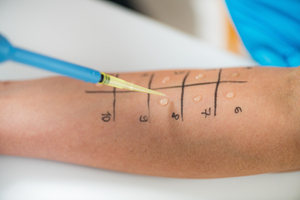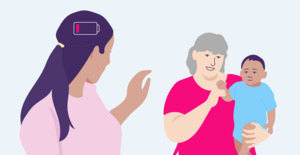Key points
- Omicron BA.2 (BA2) is now the dominant coronavirus strain in the U.S, causing milder symptoms than previous variants.
- The BA2 strain spreads faster than previous versions but vaccinations with a booster dose seem to protect against severe illness.
- BA2 is more serious for children than other COVID variants and the influenza virus, with hospitalizations on the rise.
- COVID vaccines and a booster dose can prevent severe illness, hospitalizations, and death from the BA2 variant.

The newly-emerged Omicron BA.2 (BA2) subvariant is now the dominant coronavirus strain in the United States. As of this April 2022, about 72% of the COVID-19 cases in the U.S. are from BA.2, according to the CDC (U.S Centers for Disease Control and Prevention). After causing a wave of COVID cases across Europe, the UK, and other countries earlier this year, the Omicron subvariant’s spread is now being monitored in the U.S, reports the CDC.
At this point, many of us may suffer from “pandemic fatigue.” It can be frustrating to learn about a new subvariant on the loose, just when we were beginning to resume our pre-pandemic lives. The silver lining is that, according to the CDC, BA2 causes milder symptoms than previous variants. Milder does not always translate to mild symptoms, particularly in unvaccinated and people who are immunocompromised, notes the CDC. The BA.2 strain must be monitored and reasonable precautions are being advised.
States Dr. Rob Rohatsch, MD, “The Omicron BA2 subvariant is known to spread faster than the previous version. Preliminary studies seem to suggest that this COVID strain causes milder symptoms compared to the Delta. The BA2 waves that hit Europe and the UK indicate that vaccinations with a booster dose seem to protect against severe illness, hospitalizations, and deaths. Unvaccinated people over 65, and immunocompromised individuals over 12 may be at the highest risk of infection.”
The bottom line: Omicron BA.2 subvariant is highly contagious and spreading across the U.S. This ‘stealth’ subvariant can evade vaccine protections to cause infection. However, the CDC notes that COVID vaccines and a booster dose can prevent severe illness, hospitalizations, and death.
As states lower mask requirements and social distancing mandates, should you worry? What do you need to know to stay informed? What about the Omicron variant for vaccinated individuals? How to protect yourself and your loved ones from this contagious strain?
What are the symptoms of BA.2 Omicron subvariant?
According to the CDC, Omicron causes symptoms that are similar to previous variants but, in general, less severe. While symptoms may be less severe than the Delta and other variants, this does not mean symptoms are always mild.
A Hong Kong study found that BA.2 is more serious for children than other COVID variants and the influenza virus. Researchers found that children infected with BA.2 were 18 times more likely to be hospitalized in the pediatric ICU compared to previous variants, and twice as likely compared to the flu. The study also found that children hospitalized from Omicron BA.2 were seven times more likely to die from the infection than those hospitalized from the flu. Overall, the study found that severe illness and deaths in children from BA.2 is not common, but can occur. The results are early and have not been evaluated by external experts or published in a journal.
What does BA.2 mean for parents of small children in the United States?
CDC data shows that children represent 19% of all COVID cases. However, deaths from COVID in children under 12 are extremely rare, less than 0.1%. According to doctors at UC Davis, BA.2 can have more of an impact on children compared to adults. While symptoms are mild and most infected children in the United States do not need to be admitted to an ICU, hospitalizations are on the rise.
Parents of small children may consider taking a few extra precautions, including staying updated on recommended COVID vaccines and a booster dose. The CDC recommends that everyone aged 5 years and over get a COVID vaccine. Currently, the Pfizer vaccine is authorized under an emergency use authorization by the FDA for children 5-11 years of age. Vaccines for COVID have also been authorized for use in people who are pregnant to protect both mother and child.
Find and book a COVID vaccine or booster appointment near you using Solv.
How is the Omicron BA.2 variant spread?
According to the CDC, the BA.2 variant is expected to be highly contagious and spreads through the air, similar to other COVID-19 strains.
Preliminary data from Sweden show that the level of infection from BA.2 is much higher than that from BA.1. The viral load is the amount of virus found in your body. The higher the viral load, the greater the likelihood of transmitting the infection to others, notes the data from Sweden. It is important to note that the study is early and not peer-reviewed.
How is BA.2 different from Omicron and previous variants?
Dr. Rohatsch says, “The BA.2 seems to be causing a wide range of symptoms. Experts believe that one possible reason is not the subvariant itself, but that over time, different people have varying levels of immunity from COVID vaccines or prior infections.” The CDC estimates that 95% of Americans may have already developed a level of immunity against SARS-CoV-2, the virus causing COVID-19.
How bad is it? Who is at risk of getting infected with BA.2?
The BA.2 is known as the ‘stealth’ Omicron subvariant because when it was first discovered, scientists could not track it through standard PCR tests. According to research from Denmark, BA.2 may be 1.5 times more transmissible than the original Omicron variant. The results have not been peer-reviewed yet.
The CDC reports that unvaccinated elderly over 65 are at the highest risk and 50 times more likely to be hospitalized from COVID and the Omicron variant. Additionally, individuals who received vaccinations in Fall, 2021 but did not receive a booster dose may find their immunity waning. This situation may put them at a higher risk of getting a BA.2 infection. Unfortunately, only 70% of Americans over 65 have received their first booster dose, according to CDC reports.
If you are over 50, or have underlying medical conditions that may compromise your immunity (at any age), you may be worried about Omicron BA.2. Consider discussing your personal health risk with a healthcare professional. Solv is a hassle-free way to find a healthcare provider near you or schedule a telemedicine video consultation.
Can you get reinfected with the new Omicron BA.2?
If you were infected by Omicron before, it is natural to wonder, “can I get Omicron twice?” and “Do antibodies protect me from BA.2 if I had COVID before?”
Researchers in Denmark studied over 1.8 million infections and found that reinfections are rare, but still possible. The study is not peer-reviewed yet. However, these results agree with early data from the UK that shows people infected with Omicron BA.1 can get reinfected with BA.2, though rare.
Do COVID vaccines protect against BA.2? Should you get a booster dose?
The Omicron variant, in general, has been able to evade our immune systems and protection from vaccines. However, data from NIH (National Institutes of Health) indicates that COVID vaccines have been effective in preventing serious illness and hospitalizations from Omicron.
According to the NIH, natural immunity from the virus fades over time, in about four to five months after infection. As a result, you may not get the protection you need even if you had COVID before. The CDC recommends a vaccine booster for everyone 12 years and older after completing their main COVID vaccine series to help protect against Omicron and other variants.
The FDA recently authorized a second booster shot for people aged 50 and older but health experts are still evaluating how effective it can be against the virus. The second booster is also approved for individuals 12 and older who may be immunocompromised.
If you are concerned about the BA.2 variant and would like to know if a second booster is right for you, you may reach out to a medical professional. Using Solv, you can find a healthcare provider near you or schedule an online consultation in a click of a button. You can also use Solv to find and book a COVID vaccine or booster shot appointment.
How to protect yourself against the Omicron variant?
As many states have lifted COVID restrictions and mask mandates, the CDC notes that the virus may be able to spread more easily from person to person. The best way to prepare is to be aware.
Dr. Rohatsch advises, “Keep a track of your community’s coronavirus positivity rate. The positivity rate refers to the percentage of people who test positive for the virus out of all the people who got tested. If the test positivity rate begins to rise, consider taking more precautions like wearing an N95 or KN95 mask.”
What tests detect Omicron BA.2? How can I get one?
The CDC advises to keep at-home COVID tests on hand. The Federal Government is offering 2 sets of 4 free home COVID tests for each household in the United States. Note: the tests offer a positive or negative result and do not identify the specific COVID variant or subvariant.
Apart from the at-home rapid antigen tests (RAT), lab-based RT-PCR tests are also useful in detecting the virus. You can book a lab-based rapid antigen and PCR test through Solv.
What to do if you suspect an Omicron BA.2 infection?
If you or a loved one receive positive results after testing with at-home rapid antigen tests, please follow the CDC’s recommended COVID protocols. Isolate to prevent spreading the virus. You may reach out to a healthcare professional to see if you need further testing.
If you test negative repeatedly but experience COVID symptoms, consider reaching out to a medical professional before treating yourself at home. Consider getting a lab-based RT-PCR test to be sure. If you suspect you have been exposed to COVID-19, please test as soon as symptoms develop or wait at least five days before getting tested, in accordance with CDC recommendations.
Solv may be a convenient solution for you. We offer telemedicine services in over 40 states across America.
The views expressed by authors and contributors of such content are not endorsed or approved by Solv Health and are intended for informational purposes only. The content is reviewed by Solv Health only to confirm educational value and reader interest. You are encouraged to discuss any questions that you may have about your health with your healthcare provider.
FAQs
Is the Omicron BA.2 variant more contagious than previous strains?
Yes, the Omicron BA.2 variant is known to spread faster than previous versions.
Does the BA.2 variant cause more severe symptoms?
No, according to the CDC, BA2 causes milder symptoms than previous variants.
Are children at a higher risk from the BA.2 variant?
Yes, a study found that BA.2 is more serious for children than other COVID variants and the influenza virus.
Do COVID vaccines protect against the BA.2 variant?
Yes, COVID vaccines and a booster dose can prevent severe illness, hospitalizations, and death from the BA2 variant.
Can you get reinfected with the new Omicron BA.2?
Yes, reinfections are rare, but still possible according to researchers in Denmark.
Can you get reinfected with the new Omicron BA.2?
Yes, reinfections are rare, but still possible. Research from Denmark and the UK shows that people infected with Omicron BA.1 can get reinfected with BA.2, though this is rare.
Do COVID vaccines protect against BA.2? Should you get a booster dose?
Yes, COVID vaccines have been effective in preventing serious illness and hospitalizations from Omicron. The CDC recommends a vaccine booster for everyone 12 years and older after completing their main COVID vaccine series to help protect against Omicron and other variants. The FDA has also authorized a second booster shot for people aged 50 and older and for individuals 12 and older who may be immunocompromised.
How can I protect myself against the Omicron variant?
To protect yourself against the Omicron variant, you should stay updated on your community’s coronavirus positivity rate and consider taking more precautions like wearing an N95 or KN95 mask if the rate begins to rise. It's also important to stay updated on recommended COVID vaccines and booster doses.









